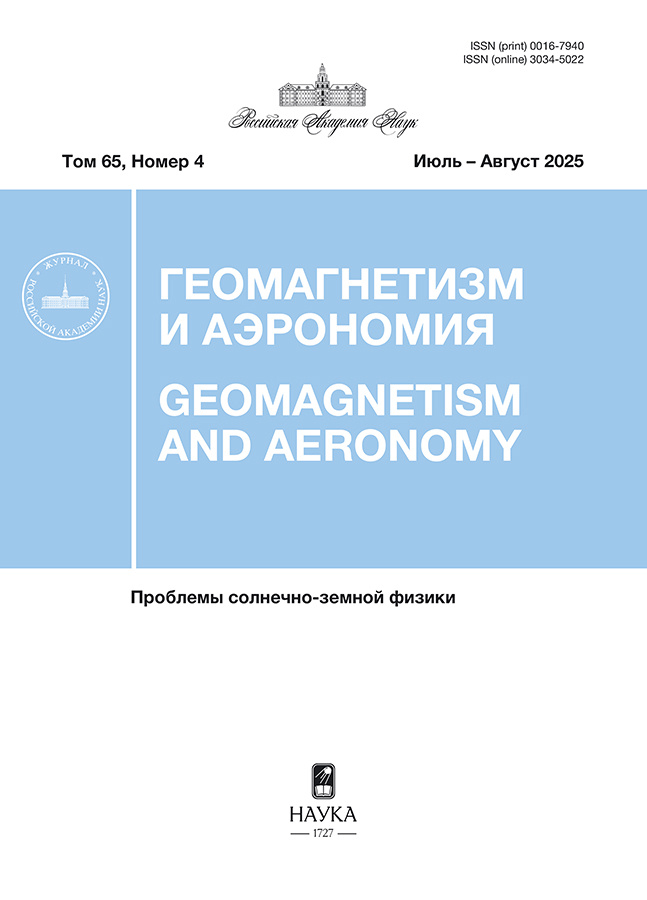Долговременные тренды ионосферных индексов солнечной активности
- Авторы: Деминов М.Г.1
-
Учреждения:
- Институт земного магнетизма, ионосферы и распространения радиоволн им. Н.В. Пушкова РАН
- Выпуск: Том 64, № 6 (2024)
- Страницы: 771-777
- Раздел: Статьи
- URL: https://transsyst.ru/0016-7940/article/view/681549
- DOI: https://doi.org/10.31857/S0016794024060051
- EDN: https://elibrary.ru/QOOKKX
- ID: 681549
Цитировать
Полный текст
Аннотация
Представлены результаты выделения трендов средних за год ионосферных индексов ΔIG и ΔT, которые получены после исключения из IG и T зависимости этих индексов от средних за год индексов солнечной активности. Индексами солнечной активности были F10, Ly-a и MgII – потоки излучения Солнца на 10.7 см, в линии Лайман-альфа водорода (121.567 нм) и отношение центральной части к флангам в полосе излучения магния 276–284 нм. Рассмотрены два интервала времени (в годах) 1980–2012 и 2013–2023. Получено, что для интервала 1980–2012 все анализируемые линейные тренды были отрицательны, т.е. величины ΔIG и ΔT уменьшались со временем. Они были очень слабыми и незначимыми. Флуктуации ΔIG и ΔT относительно трендов для Ly-a были почти вдвое больше, чем для F10 и MgII. В интервале 2013–2023 все анализируемые линейные тренды усилились и стали значимыми, т.е. увеличилась скорость уменьшения ΔIG и ΔT со временем. Для MgII эта скорость была почти в два раза больше, чем для F10. Для интервала 2013–2023 индекс MgII завышал вклад солнечного излучения в ионосферные индексы, особенно в фазу роста солнечного цикла 25, который начался в конце 2019 г. В результате, в фазу роста солнечного цикла 25 индекс F10 стал более адекватным, чем MgII, индикатором солнечной активности для ионосферных индексов. В интервале 1980–2012 индексы F10 и MgII изменялись почти синхронно. Фаза роста солнечного цикла 25 стала первым случаем нарушения этой синхронности за весь период измерения MgII.
Полный текст
Об авторах
М. Г. Деминов
Институт земного магнетизма, ионосферы и распространения радиоволн им. Н.В. Пушкова РАН
Автор, ответственный за переписку.
Email: deminov@izmiran.ru
Россия, Троицк
Список литературы
- Данилов А.Д., Константинова А.В. Долговременные вариации параметров средней и верхней атмосферы и ионосферы (обзор) // Геомагнетизм и аэрономия. Т. 60. № 4. С. 411–435. 2020. https://doi.org/10.31857/S0016794020040045
- Bilitza D. IRI the international standard for the ionosphere // Adv. Radio Sci. V. 16. P. 1–11. 2018. https://doi.org/10.5194/ars-16-1-2018
- Caruana J. The IPS monthly T index / Proc. Solar-Terrestrial Prediction Workshop. Leura, Australia. October 16–20, 1989. V. 2. Ed. R.J. Thompson. Boulder, CO: Environmental Research Lab. P. 257–263. 1990.
- Danilov A.D., Berbeneva N.A. Statistical analysis of the critical frequency foF2 dependence on various solar activity indices // Adv. Space Res. V. 72. № 6. P. 2351–2361. 2023. https://doi.org/10.1016/j.asr.2023.05.012
- Deminov M.G. Trends in ionospheric indices of solar activity // Geomagn. Aeron. (Engl. Transl.) V. 64. № 5. 2024.
- Jones W.B., Gallet R.M. The representation of diurnal and geographic variations of ionospheric data by numerical methods // Telecommun. J. V. 29. № 5. P. 129–149. 1962.
- Jones W.B., Gallet R.M. The representation of diurnal and geographic variations of ionospheric data by numerical methods. 2 // Telecommun. J. V. 32. № 1. P. 18–28. 1965.
- Laštovička J. Long-term changes in ionospheric climate in terms of foF2 // Atmosphere. V. 13. № 1. ID 110. 2022. https://doi.org/10.3390/atmos13010110
- Laštovička J., Burešova D. Relationships between foF2 and various solar activity proxies // Space Weather. V. 21. № 4. ID e2022SW003359. 2023. https://doi.org/10.1029/2022SW003359
- Laštovička J. Dependence of long-term trends in foF2 at middle latitudes on different solar activity proxies // Adv. Space Res. V. 73. № 1. P. 685–689. 2024. https://doi.org/10.1016/j.asr.2023.09.047
- Liu R., Smith P., King J. A new solar index which leads to improved foF2 predictions using the CCIR atlas // Telecommun. J. V. 50. № 8. P. 408–414. 1983.
- Machol J., Snow M., Woodraska D., Woods T., Viereck R., Coddington O. An improved Lyman-alpha composite // Earth and Space Science. V. 6. № 12. P. 2263–2272. 2019. https://doi.org/10.1029/2019EA000648
- Snow M., Machol J., Viereck R., Woods T., Weber M., Woodraska D., Elliott J. A revised Magnesium II core-to-wing ratio from SORCE SOLSTICE // Earth and Space Science. V. 6. № 11. P. 2106–2114. 2019. https:// doi.org/10.1029/2019EA000652
- Upton L.A., Hathaway D.H. Solar cycle precursors and the outlook for cycle 25 // J. Geophys. Res. – Space. V. 128. N 10. ID e2023JA031681. 2023. https://doi.org/10.1029/2023JA031681
Дополнительные файлы















